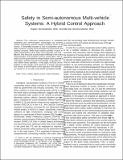Safety in Semi-autonomous Multi-vehicle Systems: A Hybrid Control Approach
Author(s)
Verma, Rajeev; Del Vecchio, Domitilla
DownloadIEEERAM-Revision1.pdf (715.5Kb)
OPEN_ACCESS_POLICY
Open Access Policy
Creative Commons Attribution-Noncommercial-Share Alike
Alternative title
Semiautonomous Multivehicle Safety
Terms of use
Metadata
Show full item recordAbstract
In this article, we have illustrated the application of a formal hybrid control approach to design semiautonomous multivehicle systems that are guaranteed to be safe. Our experimental results illustrate that, in a structured task, such as driving, simple human-decision models can be effectively learned and employed in a feedback control system that enforces a safety specification. They also highlight how the incorporation of these models in a safety control system makes the control actions required for safety less conservative. In fact, by virtue of the mode estimate, the current (mode-dependent) capture set to avoid guaranteeing safety is considerably smaller than the capture set to be avoided when the mode estimate is not available. This is essential for the practical applicability of cooperative active safety systems. In our data set, the flow entered the capture set only 3% times. These failures are mainly due to communication delays between the vehicles and the workstation. These delays, when significant, cause the calculated capture set to be different from the actual one and hence may cause to enforce control too late. These delays, in future work, should be formally accounted for in the models and in the safety control algorithm. More complex models of human decisions in the proximity of an intersection and the incorporation of additional details, such as weather conditions and road geometry, offer the potential for reducing the conservatism of safe control actions even further. Future work will also consider the extension to the case in which vehicles are not known to evolve on a fixed route. This case will be handled by keeping track of routes that are compatible with the position and speed of the vehicle and by progressively eliminating those that become incompatible. The models considered here are deterministic because most of the tools currently available to perform safety control have assumed deterministic models, wherein uncertainty is bounded. Howeve- - r, human decision models are more naturally captured by stochastic frameworks, in which uncertainty due to variability in both subjects and realizations of the same decision is probabilistic. As results in stochastic safety verification and design become available, it will be important to extend the proposed techniques of this article to safety control of stochastic hybrid automata in which the mode estimate is constructed probabilistically.
Date issued
2011-09Department
Massachusetts Institute of Technology. Department of Mechanical EngineeringJournal
IEEE Robotics & Automation Magazine
Publisher
Institute of Electrical and Electronics Engineers (IEEE)
Citation
Verma, Rajeev, and Domitilla Vecchio. “Semiautonomous Multivehicle Safety.” IEEE Robotics & Automation Magazine 18, no. 3 (n.d.): 44–54.
Version: Author's final manuscript
ISSN
1070-9932